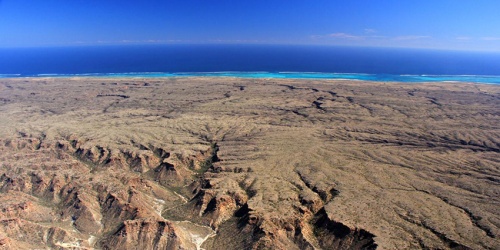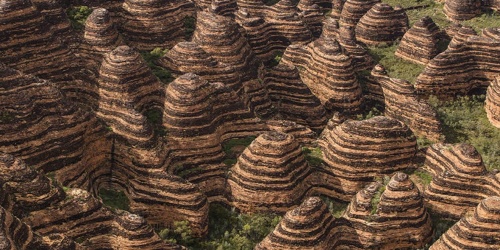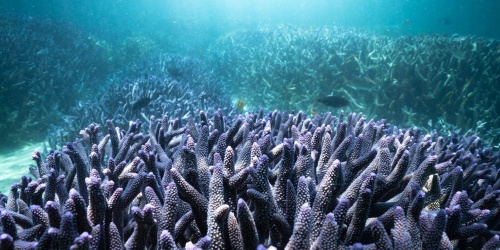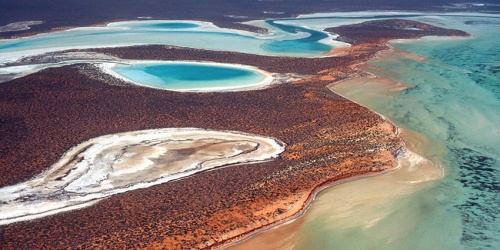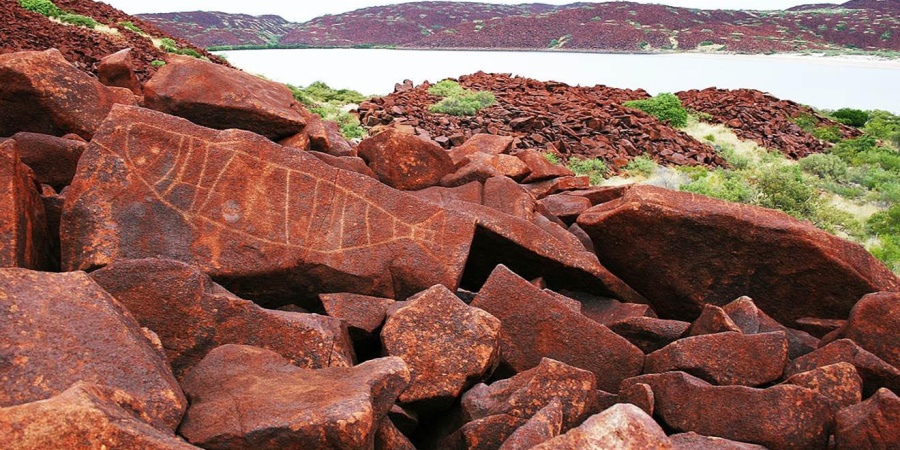
Proposed Murujuga World Heritage Area. Photo by Murujuga Aboriginal Corporation
Murujuga is the traditional Aboriginal name for the Dampier Archipelago and surrounds. It is being nominated for inscription on the World Heritage List to have its unique cultural, spiritual and archaeological values internationally recognised at the highest level.
Murujuga is home to one of the largest, densest and most diverse collections of rock art, or petroglyphs, in the world. It is estimated to contain more than one million petroglyphs. These provide an archaeological record of traditional use of the area over thousands of years. The rock art has deep meaning for the Traditional Owners. It provides a link to stories, customs and knowledge of their land and connects them to the events and people of the past and their beliefs today.
The Murujuga Aboriginal Corporation is working in partnership with the Western Australian Government to prepare the World Heritage nomination, in collaboration with the Australian Government and stakeholders.
News
- Amendment to Murujuga National Park Management Plan - Open for public comment
- Murujuga World Heritage Nomination News - November 2021 (subscribe below)
- Murujuga World Heritage Nomination News - February 2021 (subscribe below)
- New boardwalk for popular Murujuga rock art site - 26 August 2020
- World Heritage Tentative listing celebrated on-country - 26 August 2020
- Murujuga World Heritage Nomination News - June 2020 (subscribe below)
- Murujuga World Heritage listing one step closer - 28 January 2020
- Progress made toward Murujuga World Heritage status - 8 November 2019
- Land added to Murujuga National Park as plan to recognise ancient culture progresses - 25 July 2019
What is the World Heritage List?
The World Heritage List is comprised of places throughout the world that have ‘Outstanding Universal Value’. This means that the cultural and/or natural heritage values of these places are ‘so exceptional as to transcend national boundaries’ and are ‘of common importance for present and future generations of all humanity’. There are currently 1092 sites on the UNESCO World Heritage List. These include the Taj Mahal, Great Wall of China, Stonehenge and Grand Canyon National Park.
Australia has 19 World Heritage sites, including the Great Barrier Reef, Sydney Opera House and Kakadu National Park. There are currently four World Heritage Sites in Western Australia: Purnululu National Park, Shark Bay and the Ningaloo Coast, which are listed for their natural values, and the Fremantle Prison which is listed for its cultural value as part of a serial listing of the Australian Convict Sites.
The Department of Biodiversity, Conservation and Attractions is responsible for the day-to-day management of the three natural World Heritage sites in Western Australia. The Department of Planning, Lands and Heritage is responsible for managing the Fremantle Prison.
Benefits of being placed on the World Heritage List
World Heritage Listing is the highest global recognition of the importance of a place. The status confirms the outstanding and exceptional features of the listed site, which for many communities is important. This recognition provides opportunities to celebrate, through community events, the outstanding and exceptional values of the site.
World Heritage Listing also brings a commitment at local, state and national levels to protect and manage the property for present and future generations.
Inscription of a property on the World Heritage List can produce many benefits for nations and for local communities. World Heritage places are a valuable resource and can generate economic opportunities for the place and surrounding regions.
In Australia, World Heritage places are strongly promoted, and many have received increased tourist visitation. This has fostered new business and employment opportunities and economic benefits.
Why is Murujuga being nominated?
Murujuga is being nominated for inscription on the World Heritage List in recognition of its outstanding Aboriginal cultural value. Murujuga, meaning “hip bone sticking out” in the Ngarluma-Yaburara language, refers to both Murujuga Country and Sea Country and consists of a narrow peninsula of land as well as 42 inshore islands.
With more than one million images, Murujuga is home to one of the largest, densest and most diverse collections of rock art, or petroglyphs, in the world. It is estimated to contain more than one million petroglyphs, which provide an archaeological record of traditional use of the area over thousands of years. The engravings show human images, extinct animal species such as megafauna and Thylacines (Tasmanian tiger), as well as existing avian, marine and land animals. The area also features middens, fish traps, rock shelters, ceremonial places and stone arrangements. The rock art has deep meaning for Ngarda-Ngarli, providing a tangible link to stories, customs and knowledge of their land and resources, connecting them to the events and people of the past and their beliefs today.
The rock art of Murujuga of immense cultural, archaeological and spiritual significance and is an important part of Western Australia’s cultural heritage. The World Heritage nomination for Murujuga must make a strong scientifically and culturally based case that the site has ‘Outstanding Universal Value’. This means ‘cultural and/or natural significance which is so exceptional as to transcend national boundaries and be of common importance for present and future generations of all humanity'. The ‘Outstanding Universal Value’ of Murujuga will be determined through detailed research and comparative analysis to meet the World Heritage criteria and will be examined by international experts.
Who will prepare the nomination?
The Murujuga Aboriginal Corporation is working in partnership with the Western Australian Government to prepare the Murujuga World Heritage nomination, in collaboration with the Australian Government and stakeholders. The leadership and cultural guidance of the Murujuga Aboriginal Corporation is central to this World Heritage nomination process, to ensure that it adequately articulates the meaning of Murujuga to the Traditional Owners, their connection to this country and aspirations for it.
When will Murujuga be nominated?
The UNESCO deadline for Tentative List Submissions is 1 February each year and it is hoped to have Murujuga added to Australia’s World Heritage Tentative List in February 2020. This is the first major step in the nomination process, as a property cannot be considered for World Heritage Listing by the World Heritage Committee until it has been on the Tentative List for at least 12 months.
Following Tentative Listing, a formal and more comprehensive nomination dossier will be prepared. The preparation of a World Heritage nomination is a complex and challenging task. The Australian Government estimates that preparing a World Heritage nomination takes at least 2.5 years.
Who are Ngarda-Ngarli?
Ngarda-Ngarli is the collective term for the five Traditional Owner groups of Murujuga, being Ngarluma, Yindjibarndi, Yaburara, Mardudhunera and Wong-Goo-Tt-Oo, who have been part of this cultural landscape for tens of thousands of years and have a deep and spiritual connection to it.
Before European occupation of Murujuga in the 1860s, Ngarda-Ngarli were living in their own traditional lands. Many groups travelled to Murujuga for trade, marriage, kinship and to use the resources offered by the land.
Traditional Aboriginal belief is that the rock art is the work of creation spirit-beings known as Marrga (creation spirits) who, during the Dreaming times, formulated the rules of social conduct for human beings to follow. The Marrga left the rock art behind as permanent visual reminders of how the Law should be followed and they are places of continuing spiritual power. The rock art has deep meaning for Ngarda-Ngarli, providing a tangible link to stories, customs and knowledge of their land and resources, connecting them to the events and people of the past and their beliefs today.
What is the Murujuga Aboriginal Corporation?
Murujuga Aboriginal Corporation, which represents the Traditional Owner groups, was established in 2006 as body corporate for the Burrup and Maitland Industrial Estates Agreement (BMIEA). Today the Murujuga Aboriginal Corporation administers the implementation of contractual obligations of the BMIEA. Under this agreement, the Western Australian Government acquired native title rights and interests to secure the Burrup and Maitland industrial land in exchange for a range of benefits including freehold title and joint management over the Murujuga National Park.
However, the Murujuga Aboriginal Corporation is not restricted to only BMIEA business by either the BMIEA or its constitution. The Murujuga Aboriginal Corporation is partnering with the Western Australian Government to prepare the World Heritage nomination for Murujuga and implement the Murujuga Rock Art Strategy and Murujuga Rock Art Monitoring Program.
The leadership and cultural guidance of the Murujuga Aboriginal Corporation is central to this World Heritage nomination process to ensure that it adequately captures the meaning of Murujuga to the Traditional Owners, their connection to this country and aspirations for it. The Murujuga Aboriginal Corporation has around 1200 members and is the most representative group of people with cultural authority for Murujuga.
It is acknowledged that no single organisation represents all Aboriginal interests for Murujuga. Those who are not part of the Murujuga Aboriginal Corporation are able and encouraged to participate and provide input to the World Heritage nomination process, through other appropriate forums.
How is the rock art of Murujuga being protected?
he Western Australian Government is strongly committed to ensuring that there is a strategy to guide the long-term management and monitoring to protect rock art of Murujuga from the impacts of anthropogenic emissions. The Murujuga Rock Art Strategy, released on 15 February 2019, provides a framework for the Western Australian Government, in partnership with the Murujuga Aboriginal Corporation, to independently monitor, analyse, and address any impacts to rock art from emissions. The Department of Water and Environmental Regulation has primary responsibility for the day-to-day implementation of the Murujuga Rock Art Strategy on behalf of the Western Australian Government.
The Western Australian Minister for Environment has established the Murujuga Rock Art Stakeholder Reference Group to facilitate engagement between the Murujuga Aboriginal Corporation and key government, industry and community representatives on the development and implementation of the Murujuga Rock Art Strategy.
The World Heritage nomination for Murujuga will need to include a comprehensive and effective management framework that outlines how the potential ‘Outstanding Universal Value’ of the area will be protected, conserved and monitored. As part of this framework, the Western Australian Government and the Murujuga Aboriginal Corporation will demonstrate how they are working closely together to protect the rock art through the Murujuga Rock Art Strategy and Murujuga Rock Art Monitoring Program.
How will the proposed Murujuga World Heritage boundary be determined?
The World Heritage nomination will be for those significant areas of Murujuga where there is a management framework in place that can adequately conserve and protect its World Heritage value. The boundary and size of the proposed Murujuga World Heritage area will be determined during the nomination process, following effective and comprehensive stakeholder consultation and assessment of the area. The boundary of the Dampier Archipelago National Heritage Listed area will be used as a guide and starting point for this.
If Murujuga is World Heritage Listed, how will the area be managed?
A World Heritage nomination is just the start of a much longer journey toward greater recognition of an area. World Heritage properties are required to have an effective protection and management system to protect the World Heritage values for which they are listed. The existing national, State and local laws and regulations in place for Murujuga will remain and continue to guide management and decision making in the area. World Heritage Listing will not in itself change:
- ownership of land
- the way land and waters are managed, including the joint management arrangements for the Murujuga National Park
- existing land uses and activities, including the ability for Ngarda- Ngarli to undertake Customary Activities
- people’s ability to enjoy the range of recreational activities available around Murujuga, or commercial tour operations.
Is development allowed in World Heritage areas?
Yes. Development and commercial activities can and do occur in World Heritage places around the world. In Australia, there are many examples: commercial fishing in Shark Bay World Heritage area; agriculture in Willandra Lakes World Heritage area; and extensive tourism infrastructure in the Great Barrier Reef and Wet Tropics of Queensland World Heritage areas.
World Heritage Listing will not affect development as long as there are no significant impacts on the World Heritage values. Australian governments of all levels must ensure that the ‘Outstanding Universal Value' of the area are protected and managed for existing and future generations.
Existing and future industrial developments of Murujuga are covered by existing State and Commonwealth environmental protection legislation and will continue to be assessed under these on a case-by-case basis and taking into account cumulative emissions. With appropriate management, the Western Australian Government considers that industry and tourism can successfully co-exist with the cultural heritage and environmental values of Murujuga.
Will I still be able to recreate in the Murujuga area?
Yes. People will be able to continue enjoying the range of recreational activities available in the Murujuga area if Murujuga is included in World Heritage List. For example, visitors and locals will still be able to go fishing, camping, swimming, mountain-biking and four-wheel driving. Recreation activities will continue to be managed under existing Western Australian and local government laws. World Heritage Listing will not in itself change the way land and waters are managed or existing land uses and activities. World Heritage Listing does create an obligation on governments to continue to protect the values of the area.
How can I be involved?
A successful World Heritage nomination will require a collaborative and cooperative approach. Effective and comprehensive stakeholder engagement will be a key component of the nomination process to ensure the social, economic, spiritual and cultural values of Murujuga are carefully considered.
Read the latest update: November 2021
